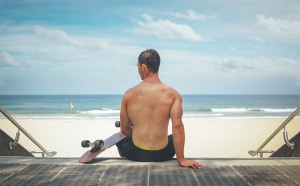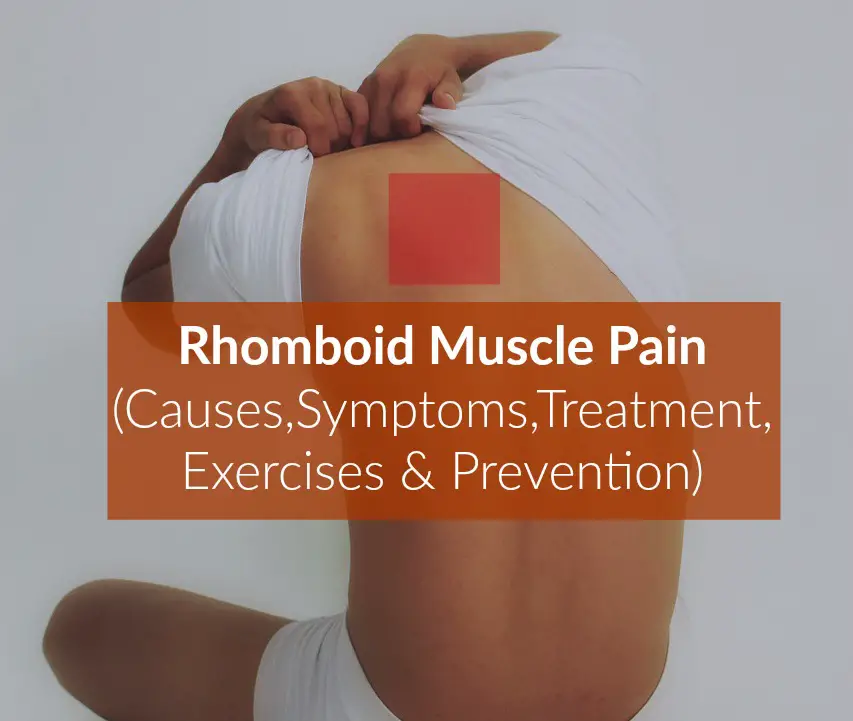The rhomboid muscles are muscles in the upper back that connect between the two shoulder blades and the spine.(1)
These muscles pull the shoulder blades together when they contract.
Rhomboids are made up of muscle fibers that run on the diagonal.
These muscles, which are diamond-shaped, including the rhomboideus minor and the rhomboideus major, are important for shoulder blade stability, movement of the shoulders and arms, as well as the maintenance of good posture.
A rhomboid muscle strain occurs when there is overstretching or tearing of the muscle’s fibers.(2)
A strain to these muscles may result in rhomboid pain or may cause muscle spasms as well.
In some cases, muscle spasms from rhomboid strains can cause the formation of knots within this muscle.
Since rhomboid muscle pain can be frustrating and may inhibit certain activities, it is important to understand the causes of this pain, the treatments available, as well as how to prevent rhomboid muscle strains from occurring.
The Causes
In most cases, it is overuse of the arm and shoulder that results in rhomboid muscle strain and spasms.(3,4)
Some of the activities that may result in rhomboid pain or strain include:
• Poor posture, particularly when sitting at a computer for a long period of time
• Doing overhead activities, such as reaching up to put items on high shelves or serving tennis balls repeatedly
• Carrying backpacks that are very heavy, particularly if the backpack is carried on just one shoulder
• Rowing
Symptoms
Some of the common symptoms that come with rhomboid muscle strain include the following:(3,4)
• Muscle pain, which may be felt between the spine and the shoulder blades
• Tightness, knots, or spasms in the rhomboid muscles
• Pain when breathing or when moving the shoulders
• Tenderness or tightness in the upper back
• Pain in the upper back that may grow worse with movement
Diagnosing Rhomboid Muscle Strain
 To diagnosis a rhomboid strain, a doctor will begin by taking a medical history.
To diagnosis a rhomboid strain, a doctor will begin by taking a medical history.
The physician will also ask about any previous injuries to your shoulders or back.
Your physician will also ask about how the present injury occurred, the symptoms you currently have, and you may be asked about the types of activities and sports you engage in as well.
Next, the physician will do a physician exam and the shoulders and back will be palpated to see if there are tightness and tenderness in the area.
You may also be asked to move the arms in specific directions to assess whether the injury is limiting your range of motion.
A physician will also ask if these movements cause you any pain.
After assessing your symptoms, medical history, and activities, as well as doing an exam, your physician should be able to tell you if you’re dealing with a rhomboid muscle strain or if your pain is caused by another problem.
Treatment and Relief
Rhomboid muscle pain and strain is usually treatment conservatively, and your physician may recommend a number of different treatment options.
Some of the common treatment methods for rhomboid muscle strain may include:(5)
» Resting – In many cases, the pain associated with the strain is made worse by movements, so you may be told to rest your upper back.
Any activity that makes the pain worse may need to be limited. If your problem is caused by rowing or tennis, you will probably be told to stop engaging in the activity for a few weeks.
» Icing the Affected Area – Applying ice to the painful area can help to reduce the pain, as well as the inflammation caused by the strain to the rhomboid muscles.
Ice packs can be applied to the area for 15-20 minutes at a time and should be done every few hours.
One of the best ways to apply the ice to the rhomboid muscles is to use the ice pack and then lie down on a bed or on the floor with the ice pack under the upper back.
Ice treatment may be used for several days, or your physician may recommend that you ice the injury more often.
After treating the pain with ice for several days, taking hot showers to relax the muscles may prove helpful.
» Medications – Your physician may recommend that you take certain medications to help relieve the rhomboid muscle pain.
Anti-inflammatory medications, such as ibuprofen, may be used to help relieve the pain and the inflammation in the area.
Other non-steroidal anti-inflammatory drugs (NSAIDs) available over the counter include aspirin and naproxen.
» Massage and Physical Therapy – If medications, ice, and rest do not eliminate the rhomboid muscle pain, a physician may recommend massage and physical therapy.
Physical therapy may help to rehabilitate the muscles.
Massage therapy helps to relax muscles and also promotes healing, and some individuals have found that it is highly beneficial for rhomboid strains and pain.
» Self Massage – If you are unable to have a massage and you need some relief from rhomboid muscle pain, you can do self-massage using a tennis ball.
Place a tennis ball down on the floor, lying down on the upper back on top of the ball.
Gently move your position so the ball rolls and massages the painful muscles.
It is also possible to purchase self-massage tools or foam rollers to help massage the rhomboid muscles for pain relief.
Once patients are able to move their shoulders and arms without any pain, they usually are allowed to go back to normal activities.
The recovery time for rhomboid muscle strain can vary from person to person, but the faster patients begin treatment, the short their recovery time will be.
While minor strains may only take a few weeks for healing, more severe rhomboid injuries may take six weeks or more to heal.
Helpful Exercises
In many cases, a health care provider will recommend some exercises to help treat rhomboid muscle pain and to help prevent further injury.
Regular exercises can help patients get back to their normal activities faster and will improve the flexibility and strength of the muscles, reducing the risk of injury in the future.
According to Pramod Kerkar, MD, some exercises that may prove helpful for individuals experiencing rhomboid muscle pain include:(6)
» Resistance Row Exercise – Take an exercise band and place it around a solid object at waist height.
Facing the object and standing about three feet away, hold on to one end of the exercise band with each hand.
Slowly pull on the band, pulling in the shoulder blades, until the elbows are at the sides. Do 10 reps.
» Rhomboid Stretch – Stretch out your arms in front of you, placing one hand on the top of the other hand, reaching forwards slowly and carefully.
This should create a gentle stretch that you feel right between the shoulder blades.
Once you feel the stretching, slowly bend the head forward, holding this position for 15-30 seconds.
Do this exercise three times. If you have strained your rhomboid muscles, use care when doing this exercise.
The goal is to improve the flexibility of the muscles, so you should never force the head down, simply move the head forward slowly and carefully.
» Neck Rotation – With your chin level, slowly, gently move your head to one side as far as you can without straining the neck.
Hold for about 15-30 seconds and then rotate your head all the way to the other side carefully, holding again for 15-30 seconds. Do this exercises three times.
» Neck Stretch – While standing or sitting, look straight ahead. Allow the head to tip to one side, moving the ear towards the shoulder with both of the shoulders down. Once the head is tipped, hold for about 15-30 seconds.
Slowly raise the head to the beginning position. Then, tip the head slowly to the other side, holding the stretch for another 15-30 seconds. Do this on both sides three times.
» Fixed Bar Stretch – Grab onto a fixed bar that is attached to a heavy object or a wall.
Stand arm’s length away from the bar. Without moving the feet, pull hips backward while straightening the legs, keeping the arms and spine straight.
You should feel the stretch in the rhomboid muscles.
» Rhomboid Twisting Stretch – This exercise for rhomboid muscle pain is a lot like a seated spinal twist.
However, you’ll twist toward the inside of a bent leg instead of toward the outside. Begin the stretch by sitting on the floor with the legs out straight to the front.
Cross the right leg over your left leg without moving the left leg. Placing the left hand on the floor behind you, reach over and grasp the right ankle with the right hand while twisting the body to the left side.
Use the elbow to push the right knee out. Repeat the twist on the other side.
» Bent Arm Stretch – Start by sitting or standing with your spine long. Bend your left elbow, reaching back behind the right shoulder.
Cross the right arm under the left arm so it is also bent. To increase this stretch, pull the left arm closer to the body.
Repeat the stretch on the other side of your body.
» Straight Arm Stretch – This exercise allows you to sit comfortably while you work on lengthening your rhomboid muscles.
Sit in a chair or cross-legged on the floor, choosing a comfortable position.
Keep the spine straight and then reach the left arm across the chest, keeping the arm straight.
Using the right hand, pull the elbow towards the chest. Your left palm should now be facing behind you.
Do this stretch on the other side as well.
Preventing Rhomboid Muscle Strain
While there are multiple ways to treat a rhomboid muscle strain and rhomboid muscle pain, the best option is to prevent this problem in the first place.
You can take multiple measures to prevent a strain or spasm to the rhomboid muscles.
One of the best ways to prevent injuries and tears to these muscles is to make sure that you stretch and warm up before you engage in activities that may affect your rhomboid muscles, such as rowing or playing tennis.
If you work at a computer throughout the day, make sure that you take plenty of breaks.
Stand up and move around and take the time to stretch the back and neck to prevent pain.
Cold Therapy Gel For Muscle Pain
Biofreeze Pain Relief Gel is an excellent pain relieving gel. In a recent research, Biofreeze decreased pain nearly 2 times as much as ice. (check price on Amazon.com)
In addition, it was rated as substantially more comfortable, patients preferred it, and pain relief lasted longer in nine out of ten times.(7)
References
(1)https://en.wikipedia.org/wiki/Rhomboid_muscles
(2)http://www.healthguidance.org/entry/15821/1/Rhomboid-Muscle-Pain.html
(3)http://www.triggerpointtherapist.com/blog/news/rhomboid-trigger-points-pain-between-the-shoulder-blades/
(4)http://helpyourback.org/back-pain/heal-your-rhomboid-strain/
(5)http://www.ndortho.com/Pt_Advisor-WEB/Rhomboid_Strain.pdf
(6)”epainassist.com/back-pain/upper-back-pain/rhomboid-muscle-pain
(7)http://www.thera-bandacademy.com/elements/clients/docs/bishop-2011-biofreeze-neck__634648161867898000.pdf
Leave Feedback: Was this article helpful?

